Abstract
The influence of expression control sequences (ECSs; promoters and ribosome-binding sites [RBSs]), transcriptional terminators, and gene orientation on the expression of the Escherichia coli lacZ gene in the gram-negative microorganisms Caulobacter crescentus and E. coli was investigated. A series of broad-host-range expression vectors, based on the RK2 plasmid derivative pRK248, were constructed. The ECSs included the tac promoter, the promoter for the surface layer protein of C. crescentus, and promoters from a number of gram-positive bacteria together with their associated RBSs. In addition, synthetic ECSs were constructed by using different combinations of promoters and RBSs. lacZ expression was found to be dependent on the nature of the promoter and RBS and, to a lesser extent, on the presence of a transcriptional terminator and the orientation of the promoter-lacZ construct in pRK248. The relative efficiencies of the various ECSs in driving lacZ expression differed markedly in C. crescentus and E. coli. In C. crescentus, the ECS ptac1 (tac promoter and consensus RBS for C. crescentus mRNAs) appeared to be the most efficient, producing 12-fold-higher activity than did pSL (promoter for the surface layer protein of C. crescentus and its putative RBS). pSL was not transcribed in E. coli, whereas various promoters from gram-positive microorganisms were transcribed in both C. crescentus and E. coli. A number of ECSs were also used to drive mosquitocidal toxin gene expression in C. crescentus, and a correlation between toxin expression and lacZ expression was observed.
Full text
PDF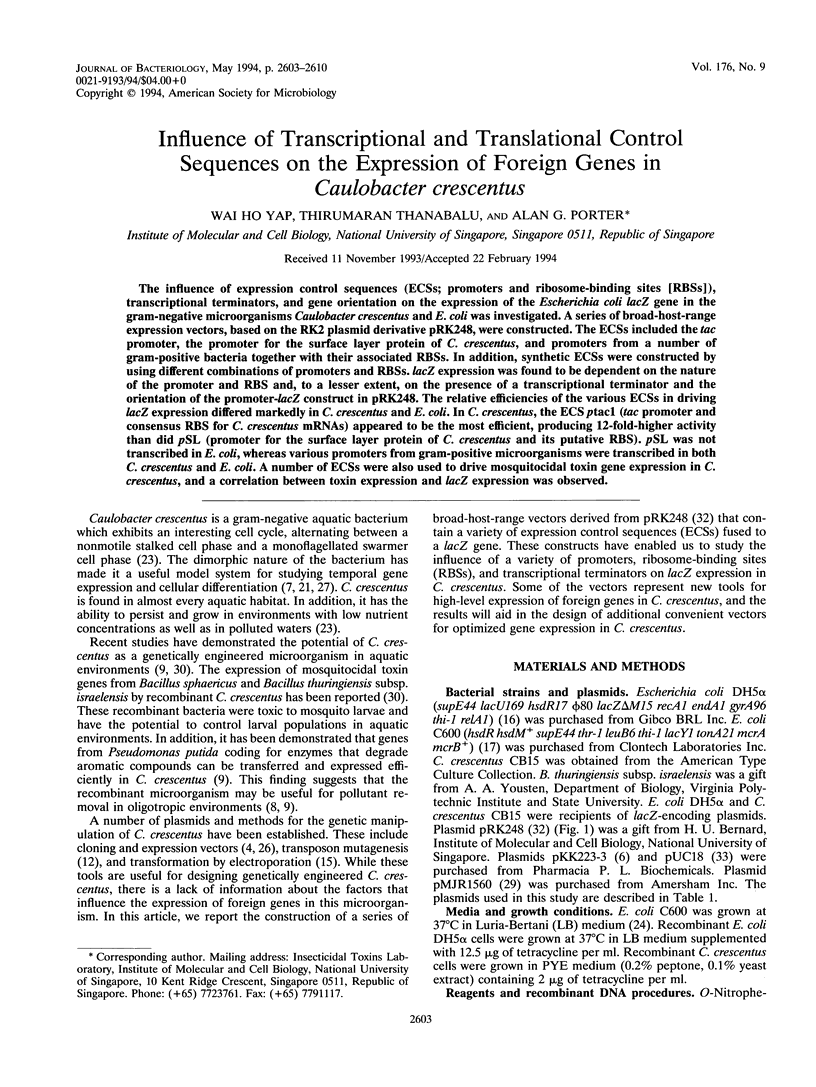
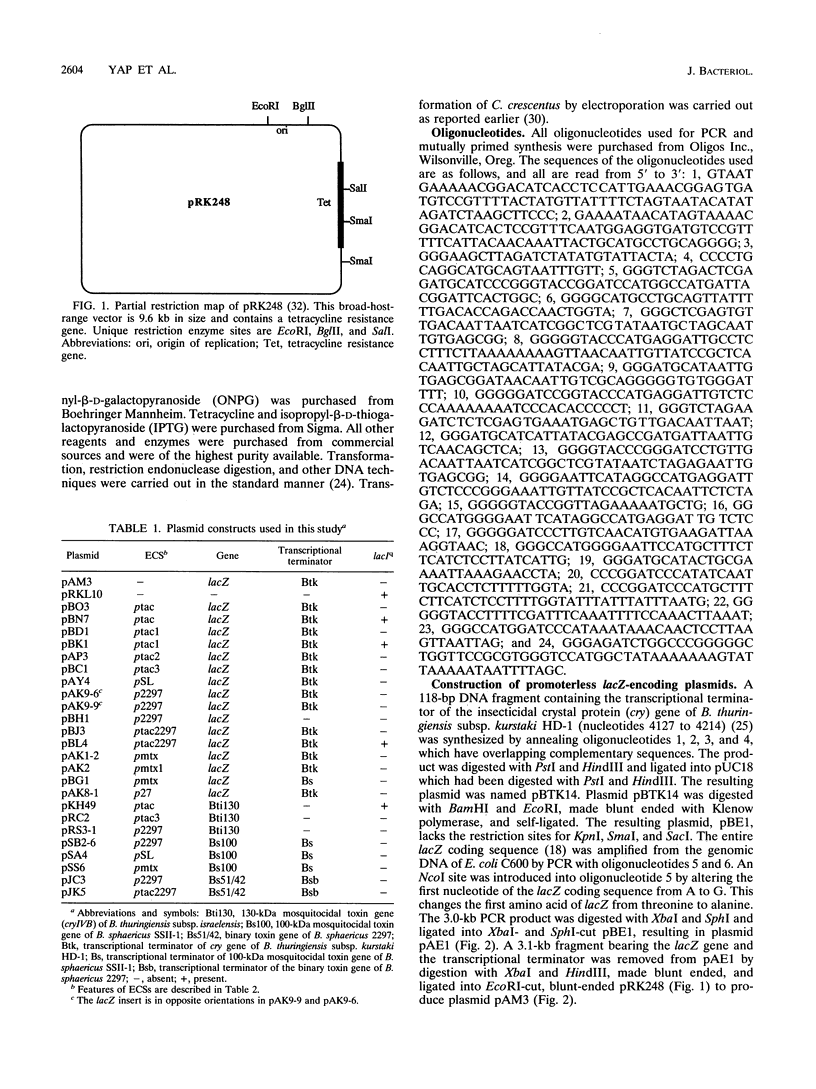
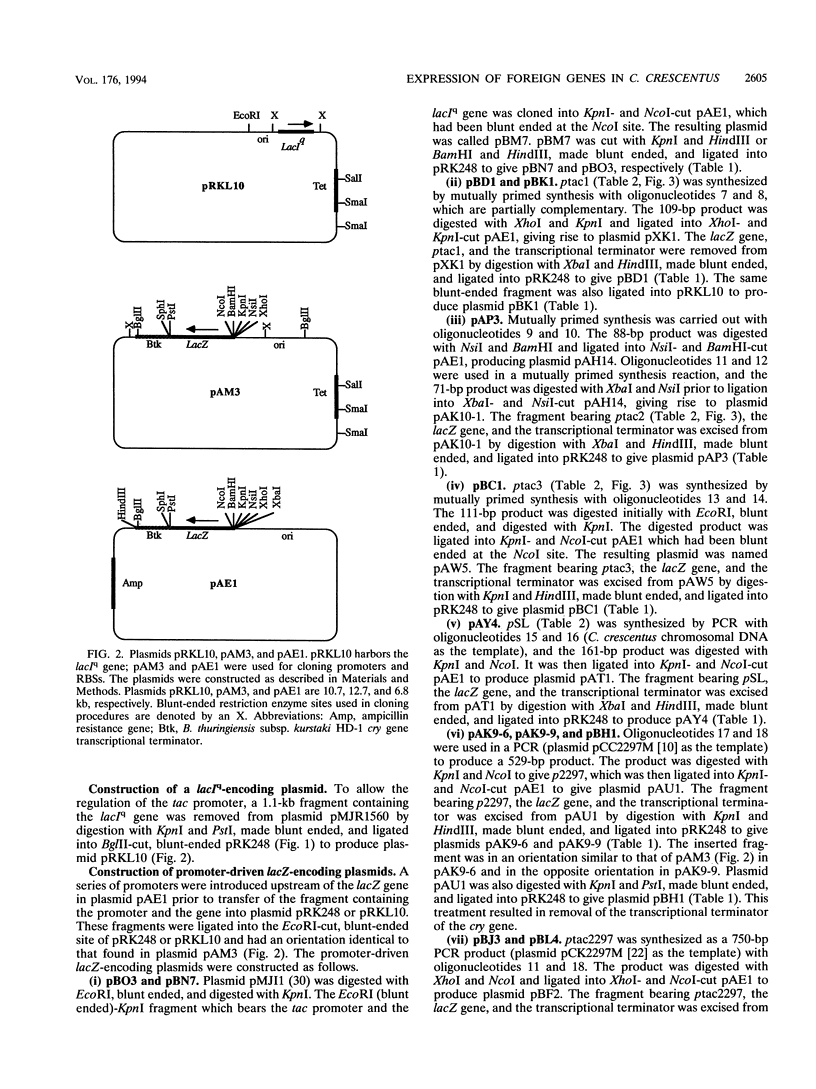
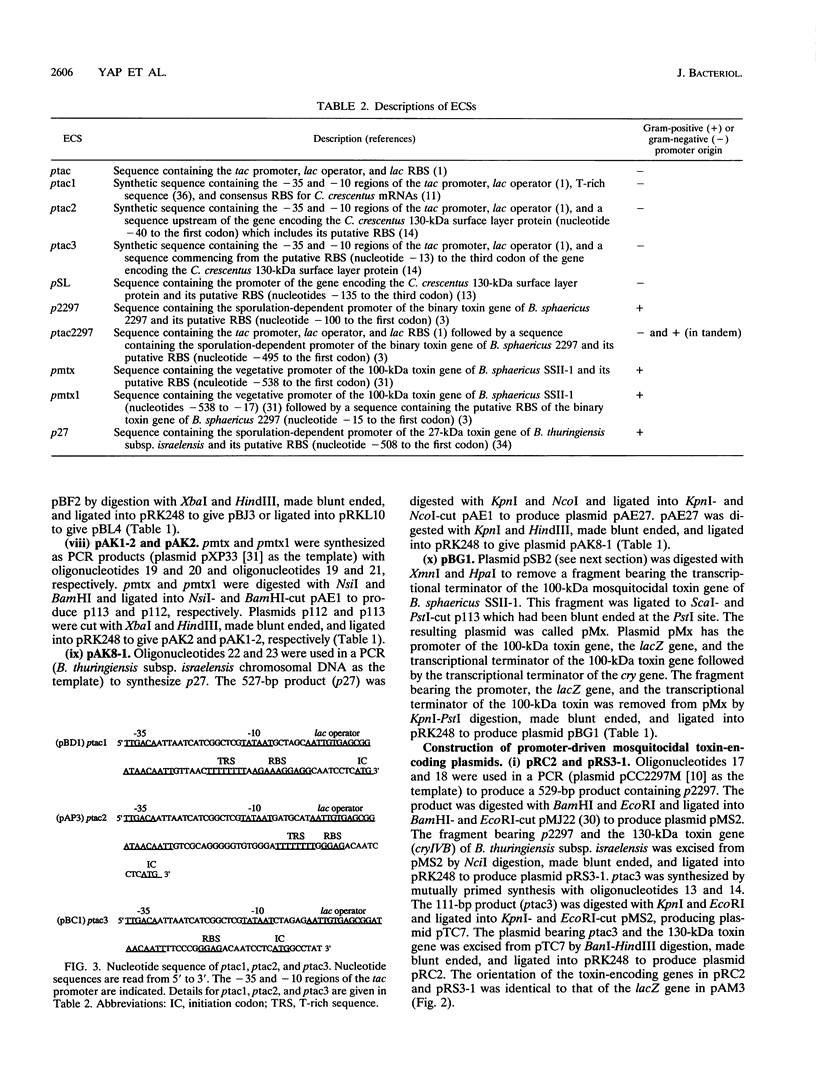
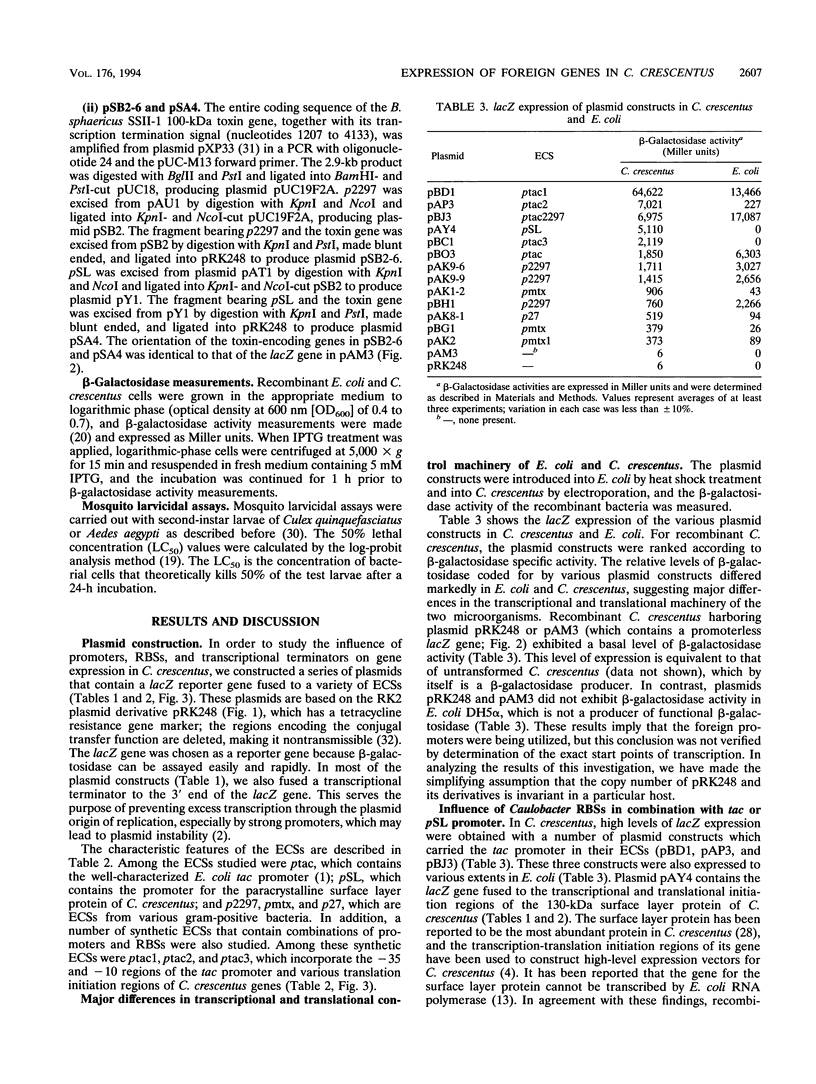
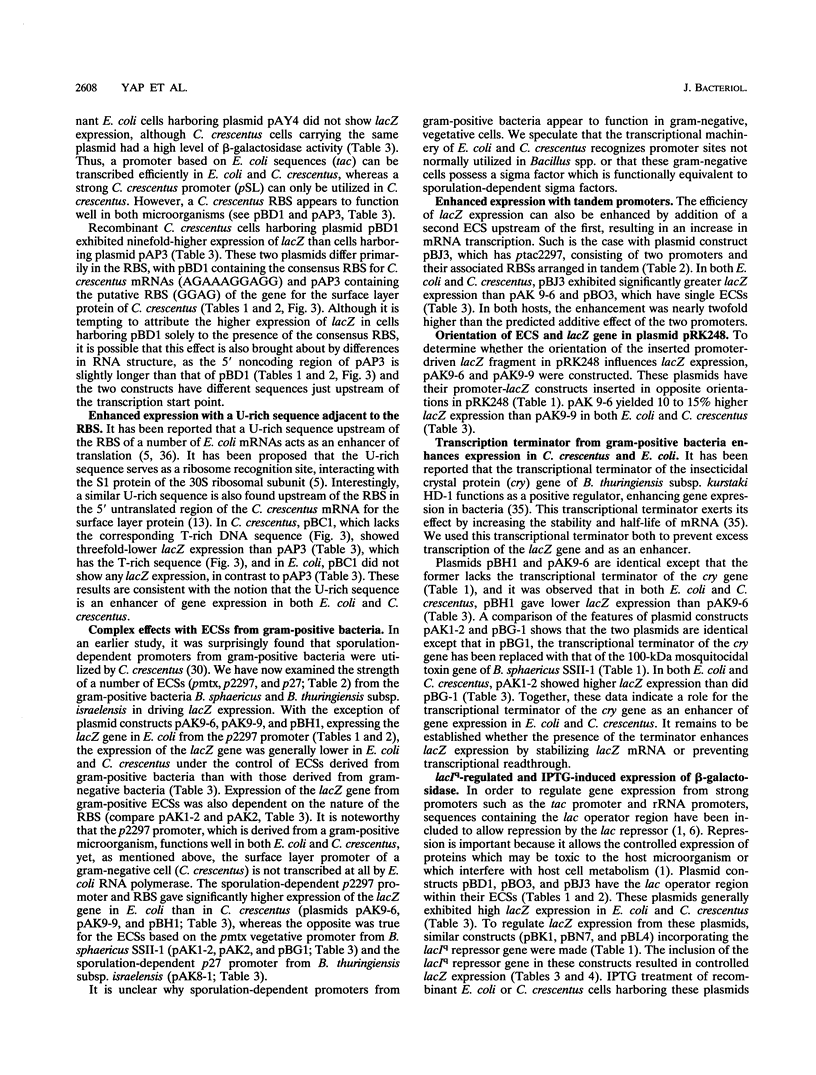
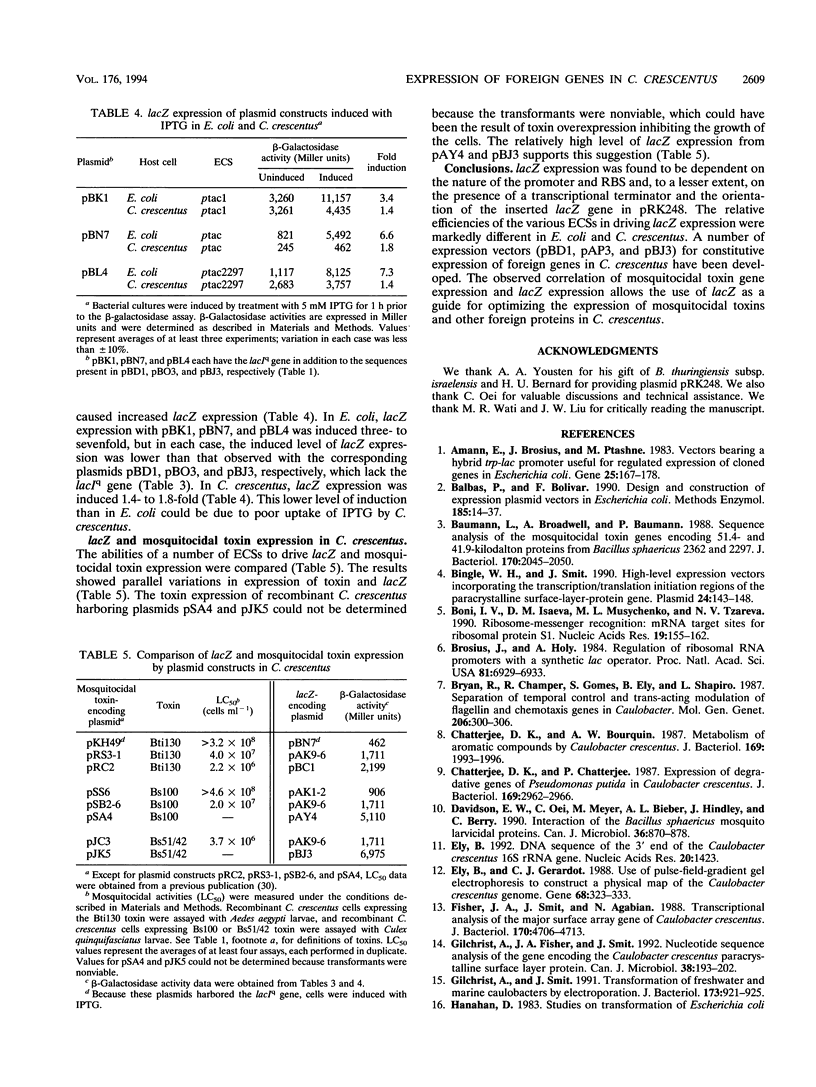
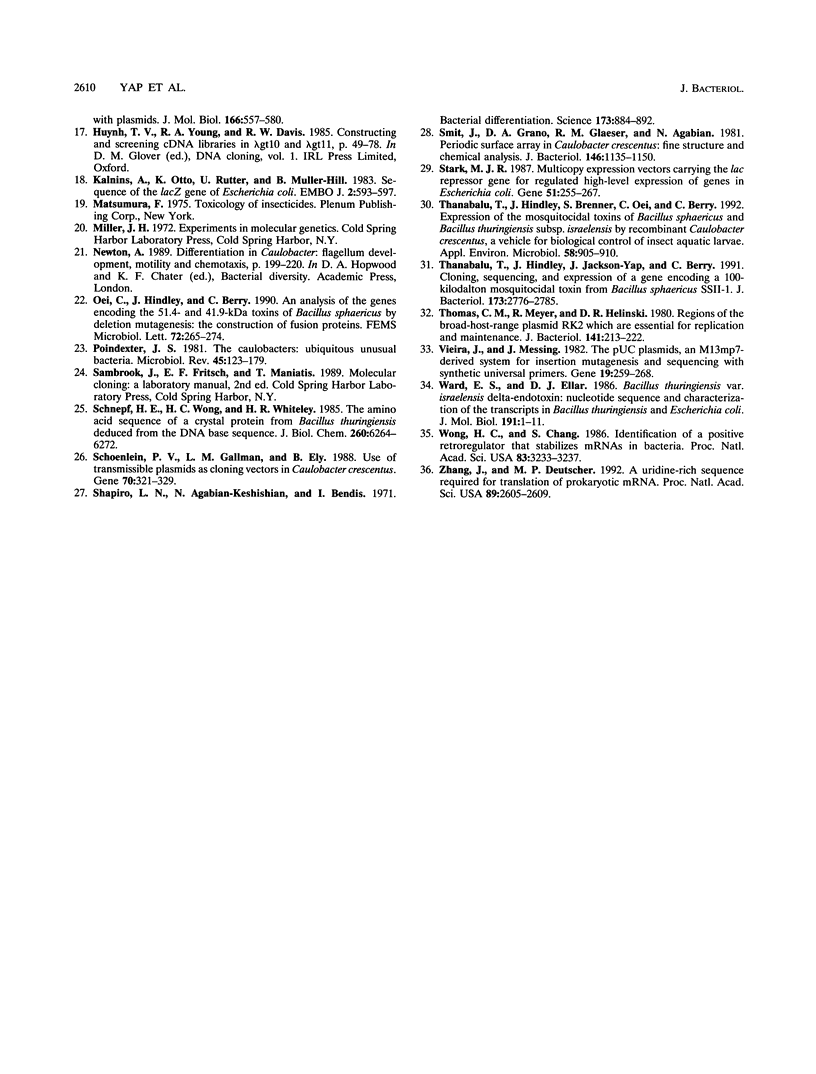
Selected References
These references are in PubMed. This may not be the complete list of references from this article.
- Amann E., Brosius J., Ptashne M. Vectors bearing a hybrid trp-lac promoter useful for regulated expression of cloned genes in Escherichia coli. Gene. 1983 Nov;25(2-3):167–178. doi: 10.1016/0378-1119(83)90222-6. [DOI] [PubMed] [Google Scholar]
- Balbas P., Bolivar F. Design and construction of expression plasmid vectors in Escherichia coli. Methods Enzymol. 1990;185:14–37. doi: 10.1016/0076-6879(90)85005-9. [DOI] [PubMed] [Google Scholar]
- Baumann L., Broadwell A. H., Baumann P. Sequence analysis of the mosquitocidal toxin genes encoding 51.4- and 41.9-kilodalton proteins from Bacillus sphaericus 2362 and 2297. J Bacteriol. 1988 May;170(5):2045–2050. doi: 10.1128/jb.170.5.2045-2050.1988. [DOI] [PMC free article] [PubMed] [Google Scholar]
- Bingle W. H., Smit J. High-level expression vectors for Caulobacter crescentus incorporating the transcription/translation initiation regions of the paracrystalline surface-layer-protein gene. Plasmid. 1990 Sep;24(2):143–148. doi: 10.1016/0147-619x(90)90016-6. [DOI] [PubMed] [Google Scholar]
- Boni I. V., Isaeva D. M., Musychenko M. L., Tzareva N. V. Ribosome-messenger recognition: mRNA target sites for ribosomal protein S1. Nucleic Acids Res. 1991 Jan 11;19(1):155–162. doi: 10.1093/nar/19.1.155. [DOI] [PMC free article] [PubMed] [Google Scholar]
- Brosius J., Holy A. Regulation of ribosomal RNA promoters with a synthetic lac operator. Proc Natl Acad Sci U S A. 1984 Nov;81(22):6929–6933. doi: 10.1073/pnas.81.22.6929. [DOI] [PMC free article] [PubMed] [Google Scholar]
- Bryan R., Champer R., Gomes S., Ely B., Shapiro L. Separation of temporal control and trans-acting modulation of flagellin and chemotaxis genes in Caulobacter. Mol Gen Genet. 1987 Feb;206(2):300–306. doi: 10.1007/BF00333588. [DOI] [PubMed] [Google Scholar]
- Chatterjee D. K., Bourquin A. W. Metabolism of aromatic compounds by Caulobacter crescentus. J Bacteriol. 1987 May;169(5):1993–1996. doi: 10.1128/jb.169.5.1993-1996.1987. [DOI] [PMC free article] [PubMed] [Google Scholar]
- Chatterjee D. K., Chatterjee P. Expression of degradative genes of Pseudomonas putida in Caulobacter crescentus. J Bacteriol. 1987 Jul;169(7):2962–2966. doi: 10.1128/jb.169.7.2962-2966.1987. [DOI] [PMC free article] [PubMed] [Google Scholar]
- Davidson E. W., Oei C., Meyer M., Bieber A. L., Hindley J., Berry C. Interaction of the Bacillus sphaericus mosquito larvicidal proteins. Can J Microbiol. 1990 Dec;36(12):870–878. doi: 10.1139/m90-151. [DOI] [PubMed] [Google Scholar]
- Ely B. DNA sequence of the 3' end of the Caulobacter crescentus 16S rRNA gene. Nucleic Acids Res. 1992 Mar 25;20(6):1423–1423. doi: 10.1093/nar/20.6.1423. [DOI] [PMC free article] [PubMed] [Google Scholar]
- Ely B., Gerardot C. J. Use of pulsed-field-gradient gel electrophoresis to construct a physical map of the Caulobacter crescentus genome. Gene. 1988 Sep 7;68(2):323–333. doi: 10.1016/0378-1119(88)90035-2. [DOI] [PubMed] [Google Scholar]
- Fisher J. A., Smit J., Agabian N. Transcriptional analysis of the major surface array gene of Caulobacter crescentus. J Bacteriol. 1988 Oct;170(10):4706–4713. doi: 10.1128/jb.170.10.4706-4713.1988. [DOI] [PMC free article] [PubMed] [Google Scholar]
- Gilchrist A., Fisher J. A., Smit J. Nucleotide sequence analysis of the gene encoding the Caulobacter crescentus paracrystalline surface layer protein. Can J Microbiol. 1992 Mar;38(3):193–202. doi: 10.1139/m92-033. [DOI] [PubMed] [Google Scholar]
- Gilchrist A., Smit J. Transformation of freshwater and marine caulobacters by electroporation. J Bacteriol. 1991 Jan;173(2):921–925. doi: 10.1128/jb.173.2.921-925.1991. [DOI] [PMC free article] [PubMed] [Google Scholar]
- Kalnins A., Otto K., Rüther U., Müller-Hill B. Sequence of the lacZ gene of Escherichia coli. EMBO J. 1983;2(4):593–597. doi: 10.1002/j.1460-2075.1983.tb01468.x. [DOI] [PMC free article] [PubMed] [Google Scholar]
- Oei C., Hindley J., Berry C. An analysis of the genes encoding the 51.4- and 41.9-kDa toxins of Bacillus sphaericus 2297 by deletion mutagenesis: the construction of fusion proteins. FEMS Microbiol Lett. 1990 Nov;60(3):265–273. doi: 10.1016/0378-1097(90)90315-h. [DOI] [PubMed] [Google Scholar]
- Poindexter J. S. The caulobacters: ubiquitous unusual bacteria. Microbiol Rev. 1981 Mar;45(1):123–179. doi: 10.1128/mr.45.1.123-179.1981. [DOI] [PMC free article] [PubMed] [Google Scholar]
- Schnepf H. E., Wong H. C., Whiteley H. R. The amino acid sequence of a crystal protein from Bacillus thuringiensis deduced from the DNA base sequence. J Biol Chem. 1985 May 25;260(10):6264–6272. [PubMed] [Google Scholar]
- Schoenlein P. V., Gallman L. M., Ely B. Use of transmissible plasmids as cloning vectors in Caulobacter crescentus. Gene. 1988 Oct 30;70(2):321–329. doi: 10.1016/0378-1119(88)90204-1. [DOI] [PubMed] [Google Scholar]
- Shapiro L., Agabian-Keshishian N., Bendis I. Bacterial differentiation. Science. 1971 Sep 3;173(4000):884–892. doi: 10.1126/science.173.4000.884. [DOI] [PubMed] [Google Scholar]
- Smit J., Grano D. A., Glaeser R. M., Agabian N. Periodic surface array in Caulobacter crescentus: fine structure and chemical analysis. J Bacteriol. 1981 Jun;146(3):1135–1150. doi: 10.1128/jb.146.3.1135-1150.1981. [DOI] [PMC free article] [PubMed] [Google Scholar]
- Stark M. J. Multicopy expression vectors carrying the lac repressor gene for regulated high-level expression of genes in Escherichia coli. Gene. 1987;51(2-3):255–267. doi: 10.1016/0378-1119(87)90314-3. [DOI] [PubMed] [Google Scholar]
- Thanabalu T., Hindley J., Brenner S., Oei C., Berry C. Expression of the mosquitocidal toxins of Bacillus sphaericus and Bacillus thuringiensis subsp. israelensis by recombinant Caulobacter crescentus, a vehicle for biological control of aquatic insect larvae. Appl Environ Microbiol. 1992 Mar;58(3):905–910. doi: 10.1128/aem.58.3.905-910.1992. [DOI] [PMC free article] [PubMed] [Google Scholar]
- Thanabalu T., Hindley J., Jackson-Yap J., Berry C. Cloning, sequencing, and expression of a gene encoding a 100-kilodalton mosquitocidal toxin from Bacillus sphaericus SSII-1. J Bacteriol. 1991 May;173(9):2776–2785. doi: 10.1128/jb.173.9.2776-2785.1991. [DOI] [PMC free article] [PubMed] [Google Scholar]
- Thomas C. M., Meyer R., Helinski D. R. Regions of broad-host-range plasmid RK2 which are essential for replication and maintenance. J Bacteriol. 1980 Jan;141(1):213–222. doi: 10.1128/jb.141.1.213-222.1980. [DOI] [PMC free article] [PubMed] [Google Scholar]
- Vieira J., Messing J. The pUC plasmids, an M13mp7-derived system for insertion mutagenesis and sequencing with synthetic universal primers. Gene. 1982 Oct;19(3):259–268. doi: 10.1016/0378-1119(82)90015-4. [DOI] [PubMed] [Google Scholar]
- Ward E. S., Ellar D. J. Bacillus thuringiensis var. israelensis delta-endotoxin. Nucleotide sequence and characterization of the transcripts in Bacillus thuringiensis and Escherichia coli. J Mol Biol. 1986 Sep 5;191(1):1–11. doi: 10.1016/0022-2836(86)90417-1. [DOI] [PubMed] [Google Scholar]
- Wong H. C., Chang S. Identification of a positive retroregulator that stabilizes mRNAs in bacteria. Proc Natl Acad Sci U S A. 1986 May;83(10):3233–3237. doi: 10.1073/pnas.83.10.3233. [DOI] [PMC free article] [PubMed] [Google Scholar]
- Zhang J., Deutscher M. P. A uridine-rich sequence required for translation of prokaryotic mRNA. Proc Natl Acad Sci U S A. 1992 Apr 1;89(7):2605–2609. doi: 10.1073/pnas.89.7.2605. [DOI] [PMC free article] [PubMed] [Google Scholar]


